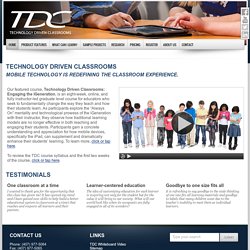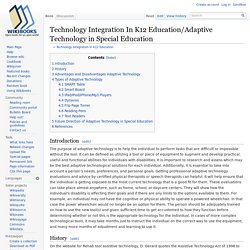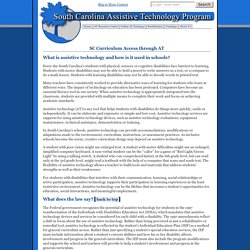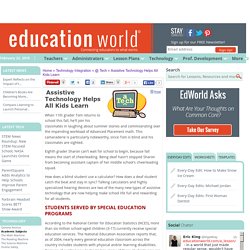

Home - Technology Driven Classrooms. Our featured course, Technology Driven Classrooms: Engaging the iGeneration, is an eight-week, online, and fully instructor-led graduate level course for educators who seek to fundamentally change the way they teach and how their students learn.

As participants explore the “Always On” mentality and technological prowess of the iGeneration with their instructor, they observe how traditional learning models are no longer effective in both reaching and engaging their students. Participants gain a concrete understanding and appreciation for how mobile devices, specifically the iPad, can supplement and dramatically enhance their students’ learning. To learn more, click or tap here. To review the TDC course syllabus and the first two weeks of the course, click or tap here. One classroom at a time I wanted to thank you for the opportunity that this class has given me! Learner-centered education Goodbye to one size fits all.
Assistive Technology. Technology Integration In K12 Education/Adaptive Technology in Special Education. Introduction[edit] The purpose of adaptive technology is to help the individual to perform tasks that are difficult or impossible without the tool.

It can be defined as utilizing a tool or piece of equipment to augment and develop practical, useful and functional abilities for individuals with disabilities. It is important to research and assess which may be the best adaptive technological solutions for each individual. Additionally, it is essential to take into account a person’s needs, preferences, and personal goals. Getting professional adaptive technology evaluations and advice by certified physical therapists or speech therapists can helpful. History[edit] On the website for Rehab tool assistive technology, D. Advantages and Disadvantages Adaptive Technology[edit] The biggest advantage for individuals who have disabilities is the greater independence they gain over their own lives with the use of appropriate tools. One of the biggest disadvantages is the cost of the technology.
What is assistive technology and how is it used in schools? What is assistive technology and how is it used in schools?

Every day South Carolina’s students with physical, sensory or cognitive disabilities face barriers to learning. Students with motor disabilities may not be able to hold a pencil to write answers on a test, or a compass to do a math lesson. Students with learning disabilities may not be able to decode words in printed text. Many teachers have consistently worked to provide alternative ways of learning for students who learn in different ways.
The impact of technology on education has been profound. Assistive technology (AT) is any tool that helps students with disabilities do things more quickly, easily or independently. In South Carolina’s schools, assistive technology can provide accommodations, modifications or adaptations made to the environment, curriculum, instruction, or assessment practices. A student with poor vision might use enlarged text. What does the law say? What are the legal definitions? Assistive Technology in the Classroom. Special ed ideas - my prezis. Assistive Technology. Computers are essential tools in all academic studies.

They can enhance the independence, productivity, and capabilities of people including those with low vision, blindness, speech and hearing impairments, learning disabilities, mobility, and health impairments. Each of these impairments poses challenges to accessing and using a standard computer and electronic resources. For example, a student who is blind is unable to read a computer screen display or standard printouts.
A student with a spinal cord injury may not have the motor control and finger dexterity required to use a standard mouse and keyboard. Access to computer-based technology for students with disabilities involves two major issues: access to the computers themselves and access to electronic resources such as word processors, spreadsheets, and websites. Adaptive (or, assistive) hardware and software can facilitate computer access for people with disabilities. Accommodations for Specific Disabilities Blindness Input Output. Education World: Assistive Technology Helps All Kids Learn. When 11th grader Tom returns to school this fall, he'll join his classmates in laughing about summer stories and commiserating over the impending workload of Advanced Placement math.

This camaraderie is particularly noteworthy, since Tom is blind and his classmates are sighted. Eighth grader Sharon can't wait for school to begin, because fall means the start of cheerleading. Being deaf hasn't stopped Sharon from becoming assistant captain of her middle school's cheerleading squad. How does a blind student use a calculator? How does a deaf student catch the beat and stay in sync? According to the National Center for Education Statistics (NCES), more than six million school-aged children (3-17) currently receive special education services. Assistive technology is defined as any item, piece of equipment, or system of products that is used to increase, maintain, or improve functional capabilities of individuals with disabilities. Article courtesy of Bridge Multimedia.